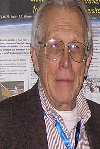
Boris A Khrenov
Lomonosov Moscow State University
Russia
Title: Phenomenology of near UV flashes in the earth atmosphere collected in satellite observations and their relation to thunderstorm regions
Biography
Biography: Boris A Khrenov
Abstract
In flights of four satellites: Tatiana; Tatiana-2; Chibis and Vernov (RELEC before launching) near UV flashes in wide range of energies (from 1 K Joule to M Joule in UV) were studied by detectors capable to measure temporal profile of the event in range of 1- 128 ms. Among all data on those flashes the most interesting are observations in Tatiana-2 and Vernov satellites series of short flashes (1 ms duration) correlated in trace of 128 ms and in several minutes of satellite flight. Series of flashes are strongly correlated with thunderstorm regions. Orbits of Tatiana’s and Vernov satellites are close to geomagnetic field while Chibis orbit crosses geomagnetic field. Series of flashes were not registered by Chibis detector. This difference gives evidence for correlation of flash series with geomagnetic field. A qualitative interpretation of data on series of UV flashes is considered. UV flashes are suggested to be generated by lightning electromagnetic pulses partly going through ionosphere to the magnetosphere as whistlers. Whistlers’ tracks are correlated to geomagnetic lines. They have a chance to come back to the atmosphere where they produce secondary flashes which could be detected by satellite following geomagnetic lines. Longer series (during seconds and up to minutes) also directed along geomagnetic field lines are due to additional effect of lightning high rate in specific thunderstorm regions.
